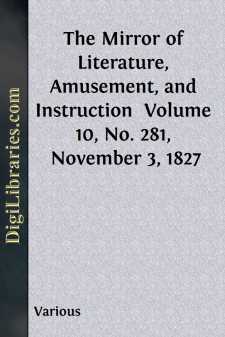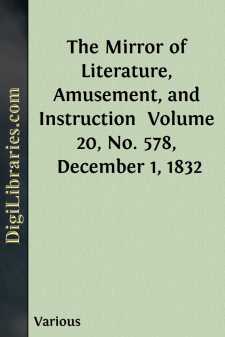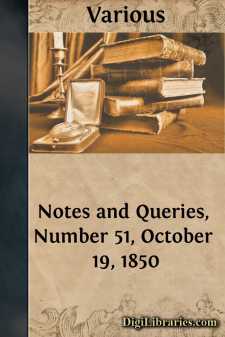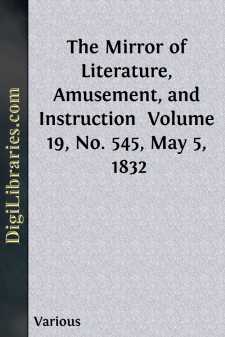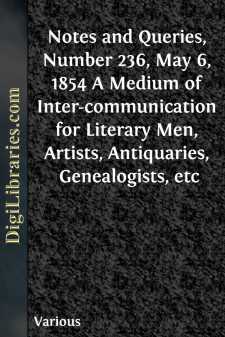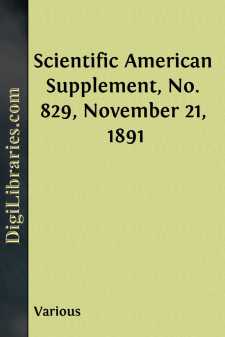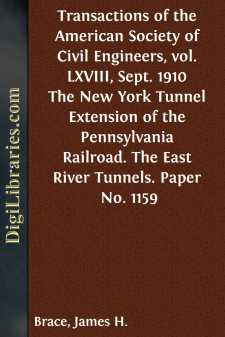Periodicals
- Art 27
- Children's periodicals 59
- Entertainment 5
- Food/Wine 2
- Games/Humor 455
- General 661
- Health 1
- History 53
- House/Home 1
- Regional 62
- Science/Nature 118
- Transportation 10
Periodicals Books
Sort by:
by:
Various
The first of the above engravings represents one of the Body Guards of the Sheikh of Bornou, copied from an engraving after a sketch made by Major Denham, in his recent "Travels in Africa." These negroes, as they are called, meaning the black chiefs and favourites, all raised to that rank by Some deed of bravery, are habited in coats of mail, composed of iron chain, which cover them from the...
more...
by:
Various
TANFIELD ARCH, DURHAM. Tanfield is a considerable village, situated seven miles from Gateshead, in the county of Durham, and eight miles in a south-west direction from Newcastle-on-Tyne. The above arch is about a mile from the village, and crosses a deep dell, called Causey Burne, down which an insignificant streamlet finds its sinuous course. The site possesses some picturesque beauty, though its...
more...
by:
Various
NOTES. ROBERD THE ROBBER. In the Vision of Piers Ploughman are two remarkable passages in which mention is made of "Roberd the robber," and of "Roberdes knaves." "Roberd the robbere, On Reddite loked, And for ther was noght wherof He wepte swithe soore." Wright's ed., vol. i. p. 105. "In glotonye, God woot, Go thei to bedde, And risen with ribaudie, The Roberdes...
more...
by:
Various
ZOOLOGICAL GARDENS, REGENTS'S PARK.Emu EnclosurePelican EnclosureAviary for Small BirdsOur strolls to this scene of intellectual amusement, (or "the gardens with a long name," as Lord Mulgrave's new heroine naively calls them,) are neither few nor far between. The acquaintance is of some standing, since The Mirror was the first journal that contained any pictorial representation of...
more...
by:
Various
AN ENCYCLOPÆDIA OF VENTILATION. "The House [of Commons] met to-day [27th April] after the Easter holidays—and honourable members, on entering, seemed highly to appreciate the unusual luxury of a little fresh air."—The Times, 28th April. The failure of some late attempts to ventilate public buildings invites me to set forth an Encyclopædia of ventilation—at a cheap rate, and in a...
more...
by:
Various
HANSA, THE LITTLE LAPP MAIDEN.BY KATHARINE LEE. Once upon a time, in a very small village on the borders of one of the great pine forests of Norway, there lived a wood-cutter, named Peder Olsen. He had built himself a little log-house, in which he dwelt with his twin boys, Olaf and Erik, and their little sister Olga. Merry, happy children were these three, full of life and health, and always ready for...
more...
by:
Various
Science needed two thousand years to disentangle the earth's orbital movement from the revolutions of the other planets, and the incomparably more arduous problem of distinguishing the solar share in the confused multitude of stellar displacements first presented itself as possibly tractable a little more than a century ago. In the lack for it as yet of a definite solution there is, then, no...
more...
by:
Various
NOTES. OLD SONGS. I heard, "in other days," a father singing a comic old song to one of his children, who was sitting on his knee. This was in Yorkshire: and yet it could hardly be a Yorkshire song, as the scene was laid in another county. It commenced with— "Randle O'Shay has sold his mare For nineteen groats at Warrin'ton fair," and goes on to show how the simpleton was...
more...
by:
George C. Clarke
The purpose of this paper is to describe the preliminary work for and the preparation of that portion of the site for the Terminal Station in Manhattan, of the New York Tunnel Extension of the Pennsylvania Railroad, which was constructed under the direction of the Chief Engineer of the East River Division, including the disposal of material excavated from all parts of the Terminal construction and the...
more...
by:
James H. Brace
This paper will be limited to a consideration of the construction of the tunnels, the broader questions of design, etc., having already been considered in papers by Brig.-Gen. Charles W. Raymond, M. Am. Soc. C. E., and Alfred Noble, Past-President, Am. Soc. C. E. The location of the section of the work to be considered here is shown on Plate XIII of Mr. Noble's paper. There are two permanent...
more...


